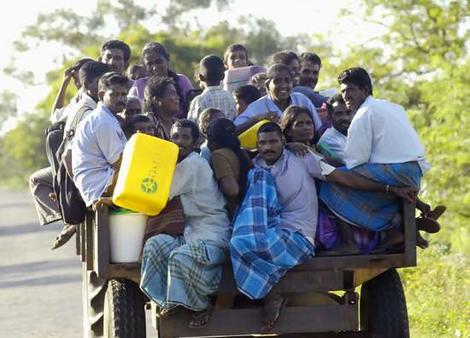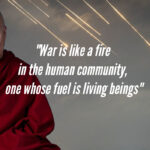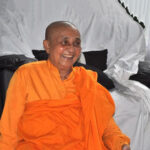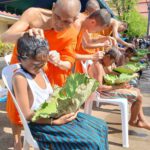 In 2010, a Peoples? Tribunal on Sri Lanka in Dublin, arranged by the Permanent People?s Tribunal in Rome, came to the conclusion that the Government of Sri Lanka can be suspected of having committed crimes against humanity and war crimes against the Lankan Tamils during President Mahinda Rajapakse?s time from 2006 onwards. Dr Sulak Sivaraksa participated in the Tribunal and supported the conclusion and also enclosed an open letter to the Lankan Mahasangha to correct its behavior. The Tribunal?s conclusion was later supported by other NGO?s, above all by the United Nations that demanded an independent examination of the suspected crimes against humanity and war crimes. See the UN Report of the Secretary General?s Panel of Experts on Accountability in Sri Lanka from 31 March, 2011.
In 2010, a Peoples? Tribunal on Sri Lanka in Dublin, arranged by the Permanent People?s Tribunal in Rome, came to the conclusion that the Government of Sri Lanka can be suspected of having committed crimes against humanity and war crimes against the Lankan Tamils during President Mahinda Rajapakse?s time from 2006 onwards. Dr Sulak Sivaraksa participated in the Tribunal and supported the conclusion and also enclosed an open letter to the Lankan Mahasangha to correct its behavior. The Tribunal?s conclusion was later supported by other NGO?s, above all by the United Nations that demanded an independent examination of the suspected crimes against humanity and war crimes. See the UN Report of the Secretary General?s Panel of Experts on Accountability in Sri Lanka from 31 March, 2011.
On January 12, 2012 a group of visitors from the USA, Canada, Sweden, Ireland, India, and Thailand met at the International Network of Buddhists (INEB) in Bangkok. In a public meeting they discussed about the role of Buddhism in the conflict in Sri Lanka. The history of the conflict was highlighted and the role of Sinhala Buddhism in it.
A documentary pictorial show demonstrated how militarization and sinhalization are combined to occupy the territory of the Tamils. There is a conceptualization which concludes that on whatever piece of land the Buddha allegedly set his foot this land becomes Sinhala-Buddhist territory. At junctions and at military camps Buddha statues and images are set up to claim Tamil territory as belonging to Sinhala Buddhists. Buddhism is reduced to an instrument for land-grabbing with the ultimate aim to strengthen the unitary state by homogenization of culture through Buddhism.
Even though the armed struggle is over since May 2009 it continues by other means. Never were reconciliation and the vision of a multicultural state further away.
We have noted that the Sri Lankan Army has prevented Tamils from remembering their dead heroes. The Army has destroyed their cemeteries by bulldozers. We have all seen in genuine documentations how dead bodies of combatants were desecrated. The desecration of bodies and especially bodies of female combatants is a war crime and a crude attack on Tamil culture.
The Sri Lankan Army denies the killing of 40 000 civilians or reduces their number by classifying the dead bodies as ?collateral damage?.
The Government of Sri Lanka prevents the Tamils from remembering a past that was full of intentions and commitments for the future. Each combatant and civilian was a symbol of hope.
The Government of Sri Lanka fears the history of the Tamils and tries to prevent them from repeating the past by forcing them to forget. Their retrieval of the past throws light over the atrocities of the Government. Therefore, it forces the Tamils to forget by hiding facts, and puts instead ?reconciliation? on the agenda. ?Reconciliation? is also a kind of expiation of its own guilt.
The Government of Sri Lanka has appointed a Committee for learning lessons from the past. The now published report covers the past. There is a need for an independent Committee as demanded by the United Nations. Tamils in the Diaspora and in the island, NGOs and the UN have reacted correctly against this policy of amnesia by demanding accountability.
Tamils have collected enough facts that should convince the international community to define the atrocities committed against the Tamils as genocide. An intended genocide is also genocide.
Let us stop here for a special remark.
If we look at all the NGOs and the UN they have in concord come to the conclusion that the Government of Sri Lanka is suspected of being guilty of crimes against humanity and war crimes. But they are silent or hesitate to name them genocide. Why is it so? The explanation is that there is a political obstacle. The rejection of the word genocide or the silence can be explained by the fear of the political implications in such a classification. These would be: opening for in intervention in Sri Lanka, the entry of a UN military force and perhaps the establishment of a caretaker government.
Let us also highlight another factor. There are still doubts about the classification of the word ?genocide?. The tribunal in Dublin in 2010 was on the threshold to accept the verdict genocide but withdrew from it in the last moment.
 The NGOs and the UN applied a perspective that was never longer than the short history of the Rajapakse Government, sometimes it even comprised only the few last months of the war. Violations appear then as occasional, time limited, depending on personalities, in short as contingent. This short perspective permits facts to be forgotten and does not highlight the specific nature of the violations as being structural in its repetition. A long perspective will show that there is not only one Mullivaikal, but several in the modern history of the island. The difference is only gradual. There are Tamils who have not only experienced the exodus from Kilinocci to Mullivaikal, but also the exodus from Yalppanam to Kilinocci in 1995. There was another exodus after July 1983 that brought many Tamils to the West and gave way to the first numbers of the present Diaspora. The planning of the attacks proved to lead to the then Ceylon government.
The NGOs and the UN applied a perspective that was never longer than the short history of the Rajapakse Government, sometimes it even comprised only the few last months of the war. Violations appear then as occasional, time limited, depending on personalities, in short as contingent. This short perspective permits facts to be forgotten and does not highlight the specific nature of the violations as being structural in its repetition. A long perspective will show that there is not only one Mullivaikal, but several in the modern history of the island. The difference is only gradual. There are Tamils who have not only experienced the exodus from Kilinocci to Mullivaikal, but also the exodus from Yalppanam to Kilinocci in 1995. There was another exodus after July 1983 that brought many Tamils to the West and gave way to the first numbers of the present Diaspora. The planning of the attacks proved to lead to the then Ceylon government.
Further back there was another internal exodus in 1958. Tamils in Colombo were evacuated by boats to Yalppanam and many other Tamils from towns in Sinhala areas had to be sent to Tamil areas for their personal safety. Many Tamils, even in the small city of Kurunegala, had to leave their businesses behind them, looted and burnt, to escape with their lives. In 1977 followed yet another pogrom.
The ultimate proof of the plan to make Tamil culture extinct followed in 1981 when the Yalppanam library was burnt down. It contained the heritage of the Tamils in the island. Where books are burnt people are burnt. That happened two years later during the Black July in 1983.
The long perspective shows that these violations are not contingent but fundamental and structural, and reveals a history of repeated pogroms.
These pogroms used to be denominated ?riots?. Today we cannot hesitate to conclude that they were racialist pogroms. True, of a lower rate than the pogroms against the Armenians and Jews, but the racialist motivation is the same. Tamil houses were plundered and burnt, Tamils were killed, Tamil women raped and murdered for one reason only; they were Tamils. In between these exoduses was a permanent fear of becoming the victims of local pogroms.
It is misguiding to focus only on the armed struggle and place its beginning to 1983. When the Government in the 1950s ordered the Sinhala-only-bill, the existing quest for a homeland was reformulated as a demand for Tamil Eelam, now as a separate state. In 1976 Tamil Eelam became the political ultimate aim and written down in the Vattukottai resolution.
We have to embrace this total historical perspective to understand the Tamils when they say that they cannot live together with the Sinhalese. The long perspective makes it clear that the criminality of the Lankan Governments is structural and genocidal, it is continuous. There is no perspective of a change of the Governments. The Sinhala majority parties UNP and SLFP carry boath a heavy burden of guilt by mongering of racial hate. By doing so they created a divide instead of reconciliation among the peoples of Sri Lanka. It goes on today.
Tamils have since long known that only the long perspective will reveal the truth about the structural and genocidal policy of the Lankan Governments. The book Lest we forget, a translation from Tamil, is a compilation of eye witnessed information written down by a group of experts from the Northeast Secretariat on Human Rights. German and French translations are in the making. It was produced in Kilinocci and dates back to the 1950?s.
The title Lest we forget hits the point. We cannot allow the Government of Sri Lanka to close the book, to make us forget. The international community cannot allow itself to draw conclusions based on a shallow knowledge of Sri Lankan political history.
There can be no reconciliation without truth; the truth is that there is a structural-genocidal trend in the policy of Lankan Governments. It makes Tamil Eelam a necessity for the future security of generations of Tamils. Tamil Eelam would be the ultimate fulfillment of restorative justice.
We have to remind the Government of Sri Lanka of what the Buddha said: ?There are only two mistakes one can make along the road to truth; not going all the way, and not starting?.
Too many Sinhalese journalists also have been killed or have had to leave their country for fear of their lives while using their right to freedom of speech to reveal atrocities. Their courage earn respect. Their words must not be silenced and they cannot be left alone in their support for the rights of the Tamils.
The road to security for Tamils also need states to support the UN demand for an independent commission. The Sri Lankan Government will bring the Tiger combatants to justice for alleged war crimes, but who will bring the Sri Lankan Government to justice if not the United Nations? It is in our hands to influence our national Governments to vote for such an independent commission at the meeting of the United Nations Human Rights Council in March 2012 in Geneva. It is also in our hands to replace political Sinhala Buddhism by universal and demilitarized Buddhism as taught by the Buddha and by his follower Dr. Sulak Sivaraksa.
?
Peter Schalk






